Lucile: Lady Duff Gordon’s Couture Legacy & Her Titanic Journey
📌 Explore the brilliant career of Lady Duff Gordon, the fashion visionary known as “Lucile,” whose elegant designs and survival of the Titanic made her a cultural icon. Discover her influence on fashion, ocean travel, and early 20th-century society through the GG Archives.

Lady Duff Gordon (Lucile). Harper's Bazar, March 1916, p. 31. GGA Image ID # 1cc8dd2c1f
📚 Review and Summary: Lady Duff Gordon “Lucile” – British Fashion Designer & Titanic Survivor 💃🚢
Lady Duff Gordon, better known by her fashion house name "Lucile," emerges not just as a leading light of Edwardian and early 20th-century fashion but also as a cultural icon whose life intersected dramatically with one of history’s most infamous ocean travel disasters—the sinking of the Titanic. This expansive article presents Lucile's remarkable influence on fashion, society, and transatlantic style, and offers rich material for students, teachers, genealogists, historians, and fashion enthusiasts alike. 🌍✂️
LUCY, Lady Duff Gordon, the famous "Lucile" of fashion, is one of those rare women of genius who, having a message to express, also has the power to express it perfectly. She is also a survivor of the Titanic disaster of April 1912.
She chose her medium woman's dress only where others of her gifted kind have worked in words, music, or colors to realize their creative impulse. She puts all the magic of true poetry, the rhythmic spell of music, and the glamour of the great artist into her creations.
This genuinely creative faculty has raised her to the unique place of leadership she now occupies. It was but a few years ago that in a small London room, with only two workers to help her, Lady Duff Gordon took the first step along the path that was to lead to such extraordinary success.
The Parisienne at Home and Abroad
By Lady Duff Gordon (“Lucile”)
Dear Mr. Editor: Some people do so hate the winter —they100k toward it with positive dread. In dear old England, where steam heat is an unheard-of joy and we freeze in crossing a corridor from one room to the , other and are only warm when hugging our bright coal fires, it is not to be wondered at. But how different is your wonderful American winter, with the sharp, crisp air and bright sunshine out-0f doors and in your houses!
There is a delightful warmth and comfort; no need to dread crossing a corridor— each and all rooms are the warmth of summer. What opportunities you have for wearing light and airy attire in the house, to be covered up by a luxurious fur garment when motoring or walking.
I think there is nothing more attractive in the world than a long fur coat, which completely conceals the garment under it, so that when paying an afternoon call you surprise your hostess by discarding your chrysalis of fur and standing revealed in all your butterfly daintiness of chiffon and lace.
This is a flight of fancy that can never be indulged in in England during the winter. In Paris, however, things are not quite so hopeless; the houses are warmed in some way or other, 50 that the people can dress in this alluring manner. I am sending you a sketch of the very last word in this style of dress.
The lady who wore it is a very well known and you can Judge for Yourself from the picture and the description underneath what a delectable frock it most certainly is. It looks especially well in mole-skin or broadtail.
Now that hats are not permitted in any of the theaters, except in a loge, all the women are wearing either turbans or queer little caps. One seldom sees an unadorned head, but if one does, the hair is done very simply and to make the head look as tiny as possible, and the ears are entirely covered.
At evening parties and private dinners, these turbans are worn tightly around the head, just as tightly as possible, and there is as much deftness needed for winding them ’round and ’round the head as that employed by a true oriental.
After you have manipulated your yards of color around your head, you pin in the jewel; and if, as is usually. The case with you American women, the diamond is one inch square and is a pendant to a large brooch, you pose your brooch on the turban on the left side and your one inch square diamond dangles just over the_left eyebrow. It greatly enhances the effect of the eyes and the diamond.
Another favorite arrangement is a band of sapphire blue velvet bound tightly around the head, on which is a simulated diamond diadem—as few women have just this diadem is real stones, more's the Pity.
From the middle of the forehead a band of diamonds goes across the head to meet the blue velvet band in the nape of the neck. On the top of the head, just half way between the forehead and the nape of the neck, is placed a gigantic black aigrette (costing $200) posed in the cap of the simulated diamonds.
Draped dresses continue the rage, with more or less of the suggestion of fullness at the hips that the pannier effect gave. This effect tends to make one look slim, and is very becoming. The long, narrow skirt around the ankles and the waist line catch the eye; their smallness is accentuated by the bulgy out-folds of the hips, which no one dreams for a moment is anything but material, even though it may hide hips of goodly proportions.
This Is an Ideal Dress for America, Designed by Lucile. It Features Two Shades of Sable Chiffon Layered Over Flesh-Pink Satin. The Skirt, Tunic, Muff, and Hat Are All Trimmed With Sable, While the Muff Is Made of Tawny Velvet. Please Note That No Patterns Are Available for This Model.
Two of the Newest Costumes by Lucile.
The Lady on the Left Is Wearing Fitted Black Charmeuse Draperies, Accessorized With an Ermine Scarf, Muff, and Orange Velvet Hat. The Other Lady Is in a Fashionable White Moire Souple, Trimmed With a Sable Tail and a Large Sable Muff. Her Hat Features Faded Rose and Blue Colors, Which Are Also Reflected in the Waistband. (Please Note That Patterns for These Models Are Not Available.)

Colorful Fashions by Lady Duff Gordon - "Lucile." Photographs in Color Made by the Campbell Studios. Harper's Bazar, January 1916, p. 48. GGA Image ID # 1cc8de5c20
"Your soul has woven on its loom of dreams
A magic fabric of divinest dyes
And all of youth, and joy, and beauty seems
To smile again into our tired eyes."
So wrote a poet to Lady Duff Gordon, whose remarkable color sense has made her artistic achievements the marvel of two hemispheres. Youth and grace are incarnate in every hue and line fashioned by her.
For her pleasure, she had designed gowns for friends of her caste. Her family determined to use her gift when a sudden financial reverse occurred. It is doubtful if she knew how great that gift was then.
The world at large was swift to acknowledge Lady Duff Gordon's talent. The tangible outcomes of this recognition are remarkable. Her first house, 'Lucile' of London, reigns over English fashion; 'Lucile' of New York sets the fashion tone in America, and her latest venture, 'Lucile' of Paris, has swiftly ascended to a prestigious position in the city of fashion.
Radiant Color in Graceful Costumes by Lady Duff Gordon

As Lucile Sees an Evening Gown, It Is a Delicious Shimmer of Silver Tissue and Rhinestones, With a Compelling Note of Black in the Half Bodice and Train of Velvet. The Long Tasseled Chain of Rhinestones Falling From Shoulder to Hem of the Skirt Adds to an Ensemble Most Harmonious With Miss Mackay's Personality. Harper's Bazar, March 1921, p. 53. GGA Image ID # 1cc63810ab
Three great houses in the world's greatest cities, each pre-eminent in her chosen field, have grown from the little London room where she began. The two work people have multiplied into more than two thousand directly employed and at least ten thousand more who touch more or less directly the energies of which this remarkable woman is the source.
Lady Duff Gordon divides her year. For the six months when she takes her place in the social world, she has a townhouse in the aristocratic Lennox Gardens, London, country estates in the North of England, a gem of a residence at Versailles - the Pavilion Mars, once the home of the famous actress of Napoleon's day - and a mansion in Paris. Her plans and ambitions will soon add other world centers to her chain.
Lady Duff Gordon first conceived the idea of the stage upon which the models pose to show off the gowns. By the way, her exceptional care for detail shows in her treatment of the models. She makes ladies in the true sense of their word, teaches them how to walk, use their hands, and speak, and trains them as carefully as though they were débutantes about to appear before royalty.
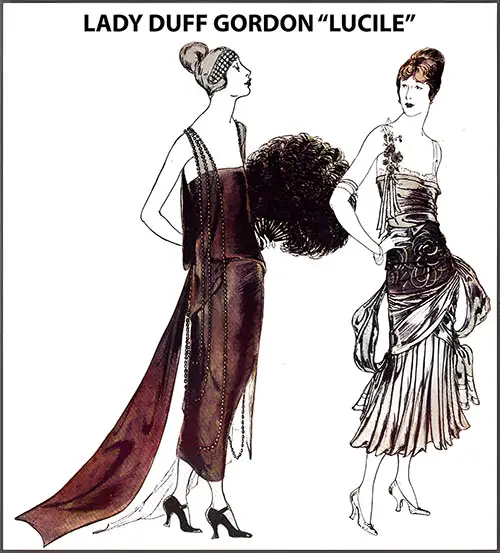
Black Satin, Slenderly Draped and Trained and Hung With Jet, Affords a Contrast to Lucile's Picture Gowns Above. The Bayadere Silhouette Is Suggested in a Deeply Girdled Dress of Purple Taffeta. The Scarf Is Purple, and the Flowers Are Silver and Rose. Harper's Bazar, August 1921, p. 69. GGA Image ID # 1cc65479b6
"My models must know how to wear clothes," she says. "They must be as unconscious of them as a duchess. They must have grace and ease of manner. They must be ladies-else. How ridiculous it is to expect them to demonstrate the dresses ladies are to wear."
She is happiest during the six months she spends in her atelier, a vast place entirely apart from the "Lucile" establishment in Paris. Here, during July, August, September, December, January, and February, she shuts herself up with her two hundred skilled workers and gives her creative genius full sway.
She goes nowhere, sees nothing of society, and will discuss no business. Nothing is allowed to disturb her. From this atelier come six hundred models a year — three hundred a season —an unequaled record of artistic masterpieces.
She holds sacred the mysteries of underdress. As she says, "something of myself" is in every gown. This devotion to detail, absolute absorption in her art, and power to express her individuality make her creations unique.
Gowns That Distill the Charm of Other Countries
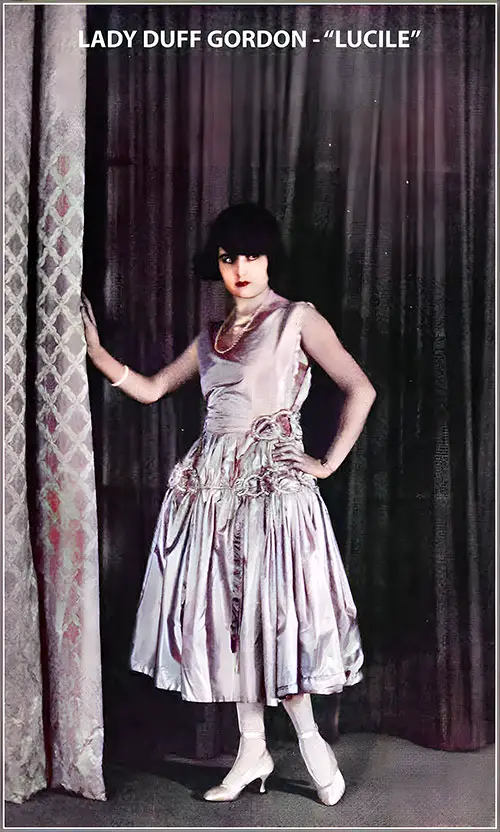
The Picturesque Staffordshire Shepherdess Type of Gown by Lady Duff Gordon With a Bit of Youthful Tilt to Its Shoulder and Flare to Its Skirt Is Made of Cyclamen-colored Taffeta. The Fulness of the Skirt Is Corded About the Hips and Held in Place by Clusters of Interlaced Circles of Rhinestones. The Bodice Extends to the Base of the Neck in Front and Back and Is Cut in the " Bateau" Neckline. The Armholes, as Deep as the Waist, Show Silver Cloth Underneath. Harper's Bazar, November 1921, p. 66. GGA Image ID # 1cc670f275
To her, at this atelier, come each year the great silk merchants of Lyons to get her ideas for the following season. And as she directs, so are the fabrics of the world designed. No one in Paris ever thinks of calling her "Dressmaker" - she is always "artiste ." Her clients are queens, princesses, nobilities, the leaders of fashion, beauties, the stars of the stage -- women of culture and discernment everywhere.
Genius is challenging to analyze. Like all great artists, she has a high degree, a sense of color, line, and composition, and a higher perception of the uncharted harmonies that few, even great ones, have. What is the secret of such success in so short a time?
Besides that unanalyzable bit, she calls "myself" —the unique individual touch permeating all. It is the characteristic stamp of the artist - inimitable and not to be mistaken. It is, of course, this individuality that makes all the difference in the world.
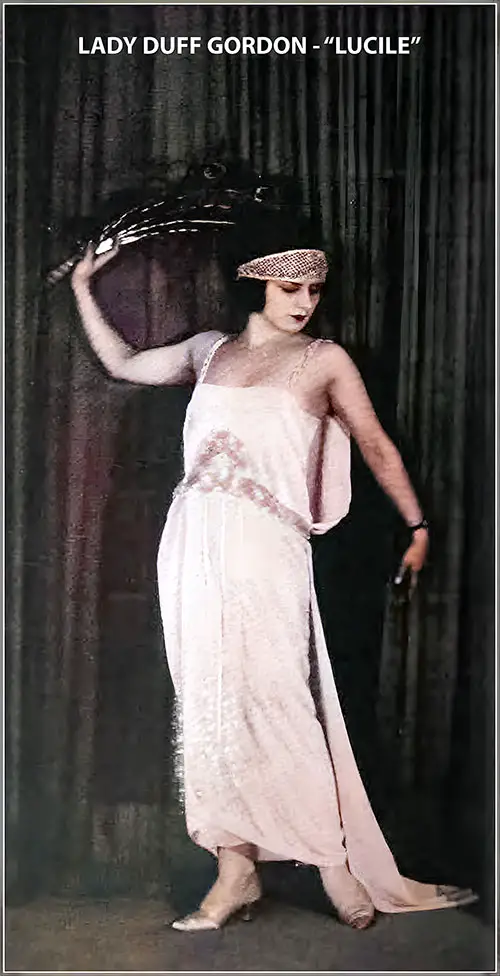
Part of the Feminine Loveliness That Was Greece Is Draped Into the Slim White Gown of Crêpe Romaine by Lady Duff Gordon. Its Flowing Panel Back, Which Also Becomes Its Train, Is Caught at the Waistline by the Exquisite Girdle of Strass and Pearls, a Girdle That Sends a Straight-hanging Shower of Crystal Beads Down the Front of the Skirt. As in Many Gowns, This Season, the Waistline and Girdle Are the Center of Interest and Supply the Critical Ornament. Harper's Bazar, November 1921, p. 66. GGA Image ID # 1cc69f0b63
But Lady Duff Gordon's problem has an element that does not enter into the work of the painter, the poet, or the musician. Her canvases are living, changing, mutable bodies. With silks, satins, laces, and ribbons, she must frame and interpret the living woman.
Any canvas will do for a painter's brush, but every dress will only look good on some women. A dress must intensify the wearer's good points, minimize the bad, and finally symbolize the woman herself. Herein, enter the unique complexities that call for the highest degree of imagination, intuition, and harmonizing perception.
Lady Duff Gordon believes each woman has a dominant chord, just as in any other masterpiece. As long as a woman must be clothed, this dominant chord must be carried out in her clothing. The result is harmony, success, strength, health, and all good things. So, she briefly runs her well-defined philosophy of dress.
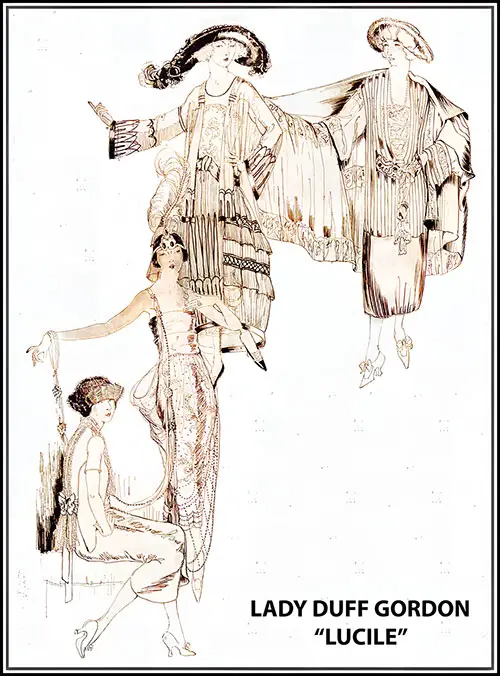
(l-r) Casino Gown of Gray Satin, Ballgown of Brilliant Green Chiffon, Dinner Gown of Black Chiffon, and a Gown and Flowing Three-Quarter Cloak. Design by Lady Duff "Lucile" Gordon. Harper's Bazar, February 1920. GGA Image ID # 1b893eb614
"The metaphysician of dress," one great Frenchman called her. This belief, which she has held consistently since she began her career and practices in everything she does, was popularly interpreted in the phrase "emotional dresses" applied some time ago to her creations.
In Lady Duff Gordon's philosophy of dress, colors are living things. Much of the witchery of her creations is due to her delicate perception of life in color. Actresses call her dresses "lucky," which is the stage phrase for recognizing her theory of harmonies but not completely understanding it.
She believes that color has its influences - in this theory, advanced science agrees with her - and that weaving together the influences that make the perfect dress, if there is the faintest bit of disharmony in color anywhere, the whole result will be wrong.
For this reason, making her models is such a tax on her strength. She always starts the fashion an entire season before it becomes the rage in Paris. Many models are gone over dozens of times, and the inspiration comes suddenly. Perhaps all that has been lacking has been a couple of delicate roses and a tiny touch of weird Egyptian embroidery. But the need has been found, and the thing is made perfect.
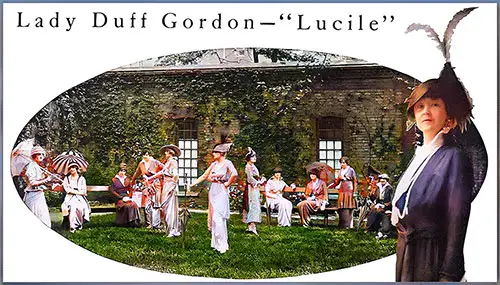
Models Posing in the Old-world Garden of the London "Lucile's." Harper's Bazar, August 1914, p. 38. GGA Image ID # 1cc1043ece
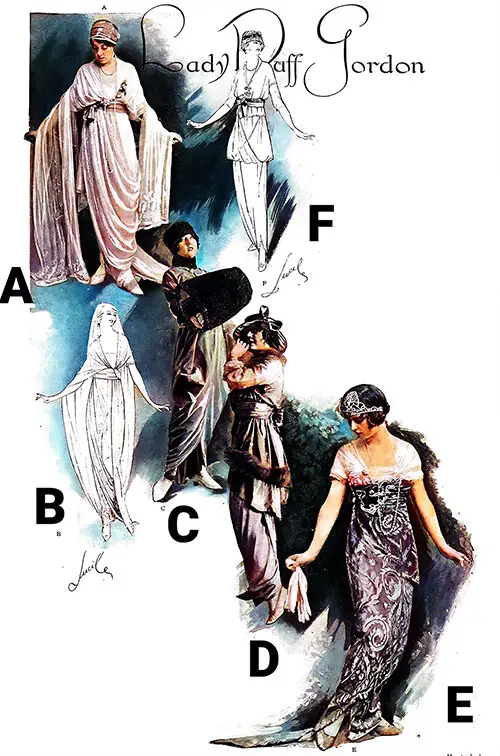
Winter Costumes and Frocks by Lady Duff Gordon. Harper's Bazar, October 1913. GGA Image ID # 21826eb922
(A) The turban, meticulously crafted with its intricate folds and vibrant hue, and the scarf, delicately draped to accentuate the neckline, synergistically elevate the allure of an evening frock in contrasting colors, inviting a deep appreciation for the craftsmanship involved.
(B) The elegance of simplicity is beautifully embodied in this dreamy costume of gray souffle d'amour, its ethereal fabric draped with one end veiling the head, creating a captivating silhouette that enchants with its ethereal beauty.
(C) The new skirt in lacquer-red ratine with the chiffon trousers showing at the sides and clinging close to the feet.
(D) One of Lucile's new models in pinky maroon velvet with fur dyed to match. An exquisite soft green and blue brocade is used for the sash and the fetching hat.
(E) Gorgeous color is reflected from the evening gown of shot metal brocade in dragon-fly-green with a diamond-embroidered bodice and a large diamond buckle at the waist.
(F) The colors of sea foam have been reproduced in this Tango frock of green marquisette, bound with Nile green satin and showing a particolored ribbon sash tied in short ends.
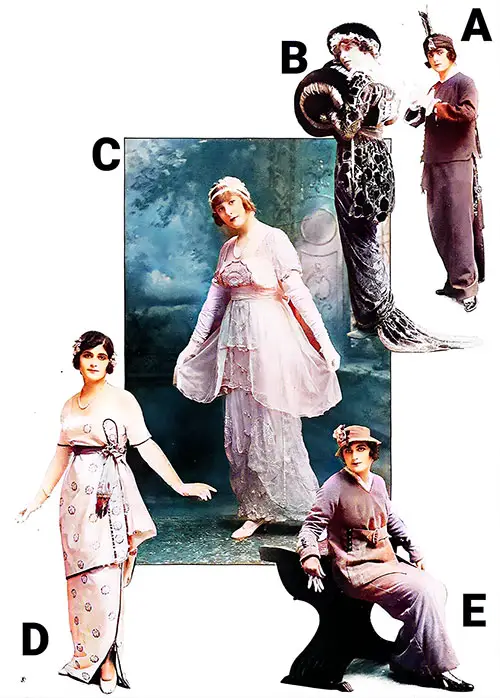
More Winter Costumes and Frocks by Lady Duff Gordon. Harper's Bazar, October 1913. GGA Image ID # 21829e29c9
(A) The Cossack suit, an actual street fashion statement, is crafted from blue serge. With its playful length, the jacket is adorned with a narrow black soutache. A touch of artistic flair is added with a sash of heavy corded silk in lavender. The baby lamb collar perfectly complements the narrow fur band on the black satin turban, while two tall, straight black quills add a striking element to the front.
(B) Envision the sheer grandeur of a reception costume in gray brocaded velvet, set against a chiffon background. The almost ethereal material, delicately layered over pink satin, casts a soft rosy hue through the gray, creating a stunning visual. The girdle and butterfly bow of silver metallic ribbon, a delightful contrast, add to the elegance. The ensemble is flawlessly completed with a gray satin turban and a round, barrellike satin muff, both elegantly trimmed with a black fox, adding a touch of luxury.
(C) Introducing the revolutionary lampshade tunics by Lucile, a testament to the unique design. These tunics, a departure from traditional wiring, rely on their fullness to create a striking bouffant effect, a design innovation that is sure to captivate. This evening gown, layered over a white crepe de Chine, is a vision of elegance. The underskirt, adorned with floral and beaded lace, is partially veiled by the pink net tunic, intricately embroidered in crystal and cut-steel beads. Over this falls the lampshade tunic of flesh-pink tulle, creating a delightful combination of pale pink and white, a design choice that adds depth and visual interest.
(D) Lucile's interpretation of the Russian blouse is exceedingly interesting, as shown in a tilleul-colored suit of heavy, ribbed ratine. The skirt is plain, and the jacket has a broad belt in the front, drawn through a Buckie, and fastening with large knob-like buttons at each side. The hat is velvet in the same grayish—green coloring, accentuated by the cluster of burnt orange flowers in the front.
(E) Lucile has developed a lovely color scheme for this evening frock of lavender Pompadour silk, with flower medallions in harmonizing shades of violet, lavender, and green. A narrow gold galloon with lavender tints outlines all the edges. A cluster of varicolored flowers in soft, pastel tones catches the loops of the sash at one side.
Dear Mr. Editor: New York, January 1920.
As you know, I am never more happy than when composing in airy fabrics for an al fresco setting, and such is now my pleasant occupation. Our Riviera—Palm Beach or the West Indies—is calling for you, and few can resist the siren song of the golden sun- tropics in gray February.
When I bought the graces for inspiration, they waved their lovely arms and answered, "Applied ornamentation." So it is to be— gowns for the morning, afternoon, and night are to be encrusted with flowers, folds, bends, gems, and whatnot, and I consider the conceit a charming one.
At the lower left is a casino gown of gray satin, faced unobtrusively with black, which I find wholly satisfying. Fichu ends of white organdie and lace depend from the round collar in the back and pass under the girdle—a surprisingly charming effect.
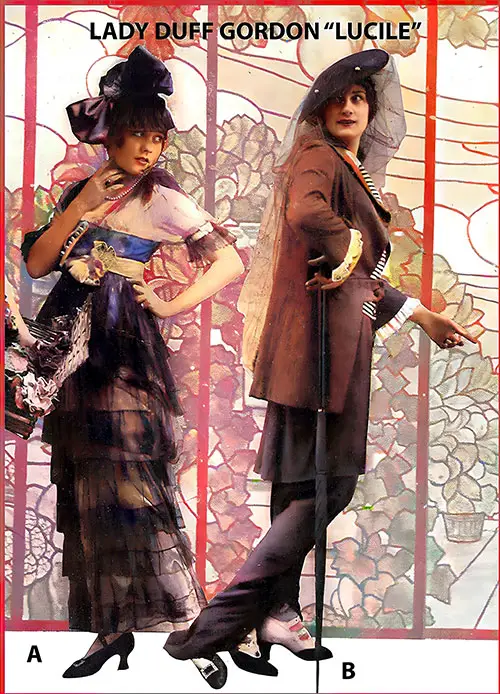
Dancing Frock and Street Costume by Lucile. Harper's Bazar, August 1914, p. 40. GGA Image ID # 1cbde5a492
(A) Lucile has conceived a delightful dancing frock by mounting a black net over white and ruffling it from waist to ankle. The flesh tints glimmer through the veiling of the net over the shoulders and arms
(b) It is one of the good-looking street costumes that Lucile recommends for traveling. Fashioned from navy blue serge, the monotony is relieved by black and white striped silk trimmings.
I like taupe and gray for the casino and present it in the form of the gown and flowing three-quarter cloak topped by a broad taupe hat at the upper right of this page. Georgette banded lengthwise on the gown and crosswise on the coat with inch-wide taupe ribbon forms the over-drapery of both wrap and gown, the foundation being the softest satin.
Then, at the upper left is my dinner gown of black chiffon, which reflects the moment's marked impulses. Black chenille of rope-like thickness is applied in striking geometrical designs as the border of the tunic, skirt, sleeves, and corsage. The corsage, incidentally, follows the latest fashion behest, for its waistline drops some inches below the normal position in front and many more in the back.
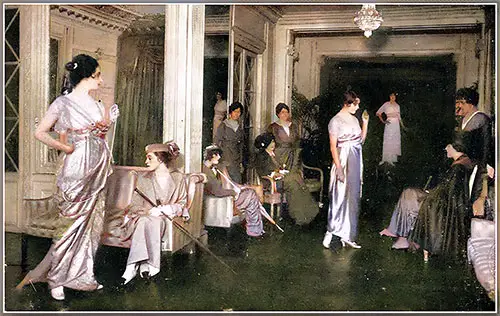
Perfect in Detail, From the Headdress to the Slippers, the Models Delight in Exhibiting the Gowns to the Clientele Who Throng Lucile's Paris Showrooms. Harper's Bazar, August 1914, p. 39. GGA Image ID # 1cbe1c516e
A picture hat of black, with a brim narrowed in front and back and widened at the sides, laden with sweeping black plumes, makes this an ideal restaurant costume. "Better fifty years of Europe than a cycle of Cathay," we Occidentals sing complacently, but how happy we are to seize upon and adapt to our Western alert use of the motifs and colorings of the drowsily gorgeous Orient.
The ballgown at the left of brilliant green chiffon, paillette in green, and dripping with chains of scintillating green beads carries an Eastern suggestion. This suggestion is emphasized by the twisted rope of chiffon and paillettes, which is caught to the right wrist and gives the wearer the air of a regal captive. A band of gold and green surmounted by a brilliant plume binds her brow.
Flowers, Folds, and Gems Encrust These Frocks
Silver tissue I use for the evening gown at the upper left of the image below, and I veil it with orange tulle. A chain-like ornament of vivid turquoise passes about the neck is caught at the waistline in front and is then drawn low over the hips to the hack of the corsage.
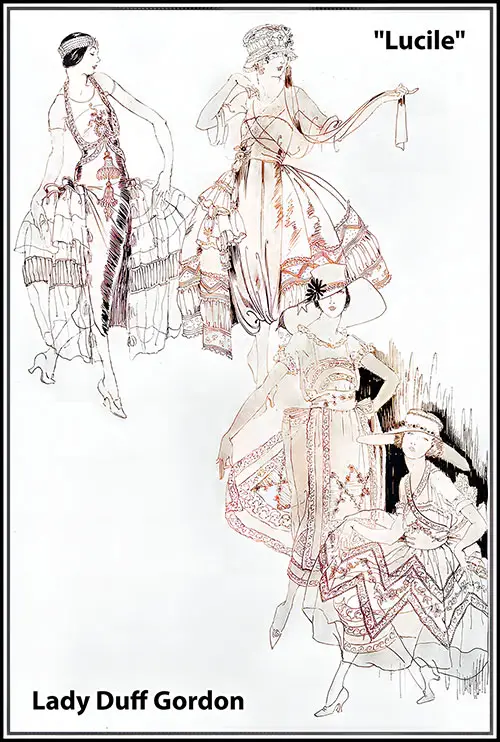
(l-r) Evening Gown, Afternoon Casino Frock, Frock of Yellow Organdie, and an Orchid Organdie Dress. Design by Lady Duff "Lucile" Gordon. Harper's Bazar, February 1920. GGA Image ID # 1b89806df6
An applied turquoise design adorns the front of the corsage, and from its base, bells of turquoise swing gracefully as the wearer sways to and fro in the dance. About the brow are chains of turquoise. East is East and West is West, but indeed, the twain have met—is it not so, Mr. Editor?
Of ecru, organdie is the lovely afternoon casino frock at the upper right, with a billowy bouffant skirt. Its tunic is bordered with a repoussé design made of rolled and frilled organdie in gray and pale écru. The small, round, close-fitting hat I make for this gown is appropriately French and nineteenth-century in line, and from its bandeau at one side, fall streamers of grayish-blue ribbon. This odd combination of neutral and supposedly antipathetic colors triumphs estheticism and elegance.
In the afternoon, you will see the habituée of the balcony or terrace clad in a lovely French organdie. I call your attention to the frock at the lower left of this page. Yellow organdie is one in which the dazzling brunette will be most effective.
Upon the apron, overskirts disport embroidered flowers of almost natural size, wrought in gay silks—the blue of the bachelor's button, the red of the poppy, the gold of the field daisy intertwines joyously. A dainty confection for the blonde is the orchid organdie at the lower right with an under and overskirt richly inset with entredeux of broad Valenciennes.

Miss Frieda Hempel's Costumes Are All Made by Lady Duff Gordon (Lucile). Harper's Bazar, May 1916, p. 37. GGA Image ID # 1cc927bdc8
It epitomizes an elegant and novel fancy in garniture—flowers and foliage, exquisitely fashioned of white organdie in half-relief, is applied to the ceinture in front and the intervals of orchid fabric in the underskirt.
With these organdie frocks, the pretty possessor will wear the most picturesque of the white straw chapeaux, the trimming of which will be but a few hand-wrought flowers. There must be no elaboration of the hat to detract from the ornamentation of the frock, isn't that so?
Sincerely,
/s/ Lady Duff Gordon
Bibliography
Lady Duff Gordon (“Lucile”): "The Parisienne at Home and Abroad." in Good Housekeeping Magazine, New York: Good Housekeeping Magazine, Vol. LVI, No. 1, Whole No. 411, January 1913, pp. 83-85.
Lady Duff Gordon: The Last Word of Fashions, in Harper's Bazar, New York: International Magazine Company, Vol. XLVIII, No. 4, October 1913, pp. 22-23.
"Lady Duff Gordon — 'Lucile'," in Harper's Bazar, New York: International Magazine Company, Vol. XLIX, No. 8, August 1914, pp. 38-40.
Lady Duff Gordon, "The Grandeur of Other Days Inspires Lucile to Garniture," in Harper's Bazar, New York: International Magazine Company, Vol. LV, No. 2, February 1920.
🔍 Why This Article is So Engaging
Historical and Biographical Depth 🕰️
The article doesn’t just skim over Lucile’s career—it dives deep into her beginnings in a small London atelier, her rise to international stardom, and her survival of the Titanic disaster. It beautifully captures the interplay between her personal philosophy of fashion and broader cultural movements, making it a treasure trove for educators and historians alike.
Titanic Connection 🚢
Lucile’s survival of the Titanic gives the piece an emotionally charged relevance to ocean travel history. Her status as a high-profile first-class passenger connects her not only to elite transatlantic travel but to larger themes of class, privilege, and female independence during the Edwardian era.
Fashion and Philosophy 👗💭
Lucile is presented as a “metaphysician of dress”—a rare view of a designer who believed clothing could reflect and even improve a woman’s spirit, energy, and identity. Her focus on “emotional dresses” and harmony of color creates rich discussion material for students and fashion theorists alike.
Lucile’s Global Fashion Empire 🌍🧵
From her original London atelier to branches in Paris and New York, Lucile’s empire revolutionized how couture was marketed, presented, and understood internationally. She invented the fashion runway show and trained her models as elegant “mannequins”—bridging theatre and fashion in a way that set the standard for modern haute couture presentations.
🖼️ Noteworthy Images
🎩 "Lady Duff Gordon (Lucile)" – This portrait immediately connects the viewer with the designer, reminding us of her aristocratic status and elegance.
💃 "Evening Gown by Lucile" (1921) – A shimmering silver tissue and rhinestone creation with a dramatic black velvet train, capturing the luxury and innovation of postwar glamour.
👒 "Models in the Garden of Lucile's London Showroom" (1914) – A rare visual insight into how couture was experienced and sold to elite clientele—ideal for students studying early 20th-century retail culture.
🌸 "Frocks Encrusted with Flowers, Folds, and Gems" (1920) – Showcases Lucile’s obsession with detail and ornamentation, reflecting her philosophy of emotional harmony through fashion.
🎭 "Gowns That Distill the Charm of Other Countries" – From Grecian drapery to Eastern mystique, Lucile’s fashion celebrated global aesthetics, reflecting the cosmopolitanism of ocean travel and port cities.
📘 Brief Dictionary of Terms
Charmeuse: A soft, lightweight silk fabric with a glossy front and dull back.
Fichu: A lightweight triangular scarf worn around the shoulders and neck.
Moire: A fabric with a rippled, “watered” appearance, typically silk.
Organdie: A crisp, sheer cotton fabric often used for summer frocks.
Paillettes: Small, flat sequins used for decorative sparkle.
Pompadour Silk: Luxurious silk with floral patterns, popular in the 18th century and revived in early 20th-century couture.
Ratine: A woolen fabric with a rough surface, often used in outerwear.
Soutache: A narrow, decorative braid used to trim garments.
Tulle: A fine, lightweight netting often used for veils or evening gowns.
🧭 Relevance to Ocean Travel and Fashion
Lucile’s story is perfect for illustrating how fashion intersected with ocean liner culture during the Gilded Age and Edwardian period. Her clients included actresses, aristocrats, and first-class passengers traveling aboard ships like the RMS Titanic. Her designs reflected the elegant yet practical demands of transatlantic travel—fur-trimmed coats, layered chiffon gowns, and chic hats suitable for promenading on deck or dining in first-class salons.
Madame Lucile also anticipated the fashion needs of fashionable cruise-goers long before the age of jet travel. Her ensembles for shipboard life—lighter fabrics, adaptable eveningwear, and stylish travel costumes—foreshadowed modern resort fashion. 🚢👒
🎓 Educational Use and Essay Encouragement
Teachers and students interested in the following topics will find a rich mine of material:
✨ The rise of haute couture and global fashion empires
🎭 Costume design and early 20th-century theatre fashion
🧳 The social history of first-class women and their travel habits
👩🎨 Women entrepreneurs in Edwardian and interwar culture
📚 Fashion’s role in self-expression and cultural identity
Encourage students to use the GG Archives in essays and projects, especially when examining fashion’s role in historical contexts like ocean travel, war, and social class. This article offers primary-source quality commentary and visuals ideal for analytical writing. 🖊️📖
Thanks for exploring the world of Lady Duff Gordon with us! 🎩✨ Her work reminds us that fashion is not just what we wear—it’s how we express, survive, and transform. Encourage your students to look beyond the seams and into the social fabric of history. 🧵📚
